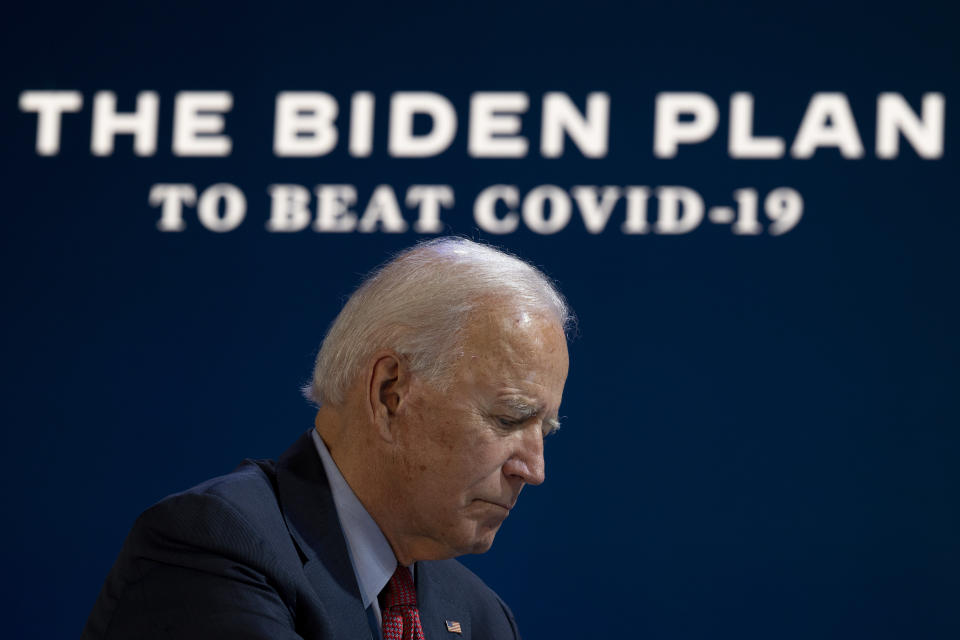How Trump lost moderate voters
This might sound hard to believe, but back in 2016, many voters viewed Donald Trump as the more moderate of the two candidates running for president. Sure, he was bombastic and combative, with nasty words for immigrants. But he was also a businessman who used to be a Democrat and made a convincing case that he’d solve problems more effectively than Hillary Clinton, whom he defeated.
Four years later, voters see Trump much differently. “Trump lost the mantle of moderation,” Rob Griffin of the Democracy Fund Voter Study Group says in the latest episode of the Yahoo Finance Electionomics podcast. “People no longer see him as a moderate figure in American politics. It just appears that he's lost it over the course of his presidency.”
Voters tend to reward moderate candidates who don’t threaten to change too much, especially when there’s no urgent crisis, as in 2016. Trump did have some radical proposals back then, such as imposing 45% tariffs on all Chinese and Mexican imports and building a wall along the entire Mexican border. But some voters shrugged that off while cheering his ideas about boosting the U.S. economy. Others assumed he was overstating his case, and in fact, Trump’s China tariffs are much smaller than he promised and his wall project has barely materialized.

In a May 2016 Economist/YouGov survey, 27% of respondents described Trump as moderate while just 25% described Clinton that way. That 2-point gap widened to 19 points among seniors who vote in the largest numbers.
In a September 2020 Economist/YouGov survey, just 16% of respondents said Trump is a moderate, while 28% viewed Biden as moderate. Among seniors, Biden now tops Trump as a moderate, by 25% to 13%. Trump likes to tout his appointment of three conservative Supreme Court justices, his support among evangelicals and his cop-friendly law-and-order message, but this may turn off centrist voters who don’t want radical change. Trump faces a related problem when he tries to energize his infamous base by attacking everybody who’s not part of the base, but ends up alienating many others tired of political combat.
Seniors ‘abandoned’ Trump
How voters view the candidates is a matter of messaging as well as reality, of course, and Biden may be surprisingly effective, given his low-volume campaign. Biden ran in the Democratic primaries as a moderate, compared with the disruptive agendas of Bernie Sanders, Elizabeth Warren and several others to his left. And Biden now boasts that he beat his leftist foes because he’s a moderate who can appeal to Independents and even some Republicans. Yet Biden’s agenda is more liberal than Barack Obama’s in 2008 or 2012, and Biden has moved leftward since securing the Democratic nomination in the spring. Trump repeatedly calls Biden “radical” and “socialist,” but it’s not sticking, suggesting Trump lacks credibility beyond his loyal base.
The portion of voters viewing Trump as conservative grew from 31% in 2016 to 49% in 2020. That’s not inherently bad, but it indicates Trump turned out to be a different kind of president than many voters expected. It also suggests Trump was losing support among some people who voted for him—especially seniors—even before the coronavirus pandemic exploded in March.

“Even before those things, it appears that seniors had already kind of abandoned Donald Trump,” Griffin says. “A majority of them were already voting for Joe Biden or leaning towards Joe Biden or at the very least, Trump had lost ground relative to 2016. There was something happening even before [coronavirus].”
Trump faces long odds in the final days of the 2020 election, with most forecasts calling for a Biden win in the electoral college. Voters give Trump poor marks for handling the coronavirus, and presidents rarely win reelection during or immediately after a recession. Trump won with a tiny margin in 2016 and has done little to expand it, instead picking constant battles with Democrats and critics.
Trump’s base is also shrinking, due to demographic factors such as immigration, aging and the growing commonality of college degrees. Griffin estimates the share of white, non-college-educated voters—the core of Trump’s base—will decline by about three percentage points from 2016 to 2020. Trump won four battleground states—Michigan, Wisconsin, Pennsylvania and Florida—by smaller margins, and without those states he would have lost. Trump needs to offset those lost votes and then some, yet voters seem to be saying he’s heading in the opposite direction.
Rick Newman is the author of four books, including “Rebounders: How Winners Pivot from Setback to Success.” Follow him on Twitter: @rickjnewman. Confidential tip line: rickjnewman@yahoo.com. Encrypted communication available. Click here to get Rick’s stories by email.
Read more:
Get the latest financial and business news from Yahoo Finance
Follow Yahoo Finance on Twitter, Facebook, Instagram, Flipboard, SmartNews, LinkedIn, YouTube, and reddit.



